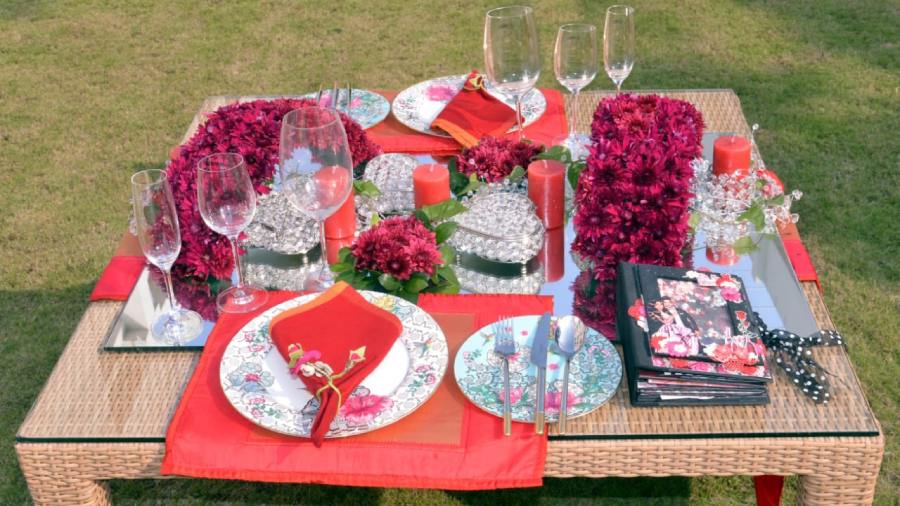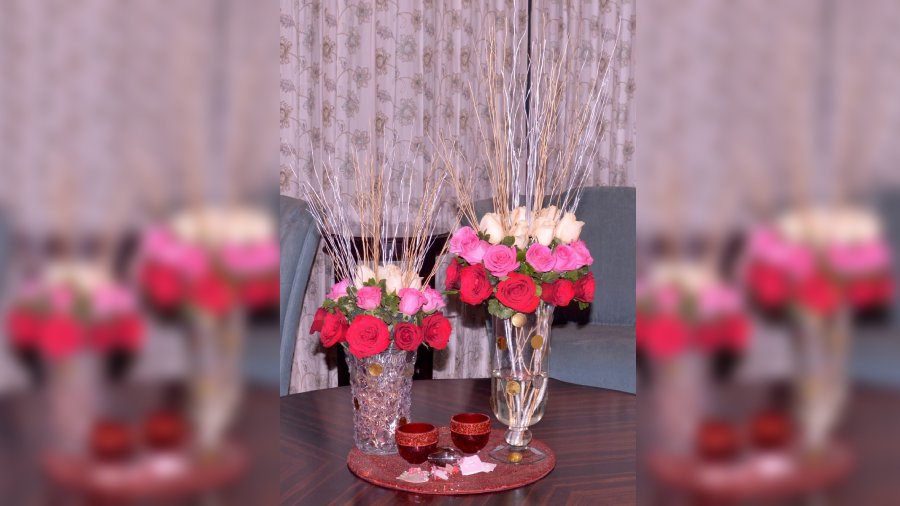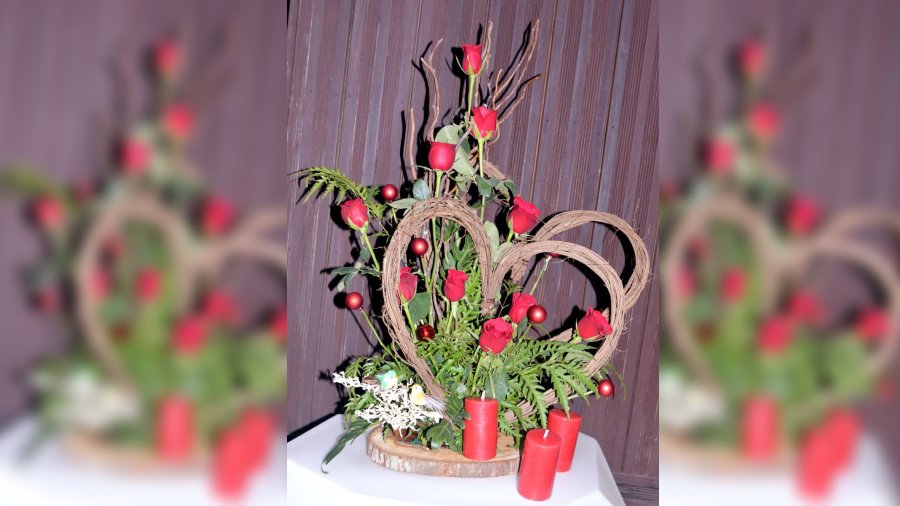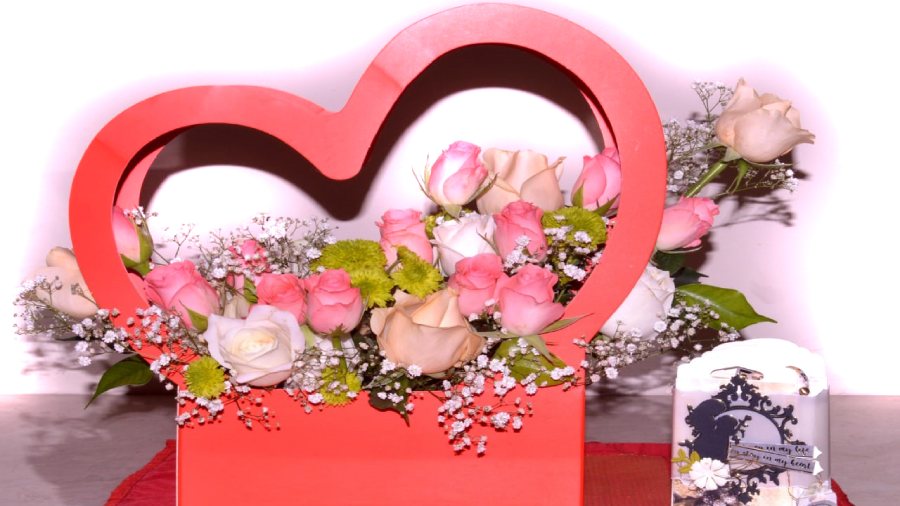The celebration of love and gifting of chocolates and flowers has become a ritual world over on February 14 each year. The history of Valentine’s Day and the story of its patron saint is shrouded in mystery. St Valentine’s Day as we know it today has vestiges of both Christian and ancient Roman traditions, but a large part of the world celebrates it with people spending special time together to honour love and affection with partners, family and friends.
It is fortuitously when the snow starts melting in colder regions and just before the onset of spring that this beautiful day is celebrated. So, we get both the winter and spring flowers in mid-February. The five most popular flowers are roses, tulips, orchids, carnations and daises. The roses signify true and everlasting love, tulips beauty and sophistication, ruffled carnation blooms mean fascination and new lovers, orchids imply warmth, happiness and loyalty, and daisies beauty, innocence and purity. Most of these flowers are arranged with locally available green leaves that add elegance and strength to each of the following arrangements.
Dining Splendour

This beautiful piece is created with a mirror, red candles, crystal-studded jewellery boxes filled with chocolates and candies, flowers, crystal-wired creepers, a little bouquet of flowers, wine glasses, champagne glasses and folded napkins with crockery and cutlery. And all without breaking the bank.
A 3ftx2ft mirror forms the base of this reflective arrangement. Two arched oases are assembled with clips and wires and totally covered with dark pink chrysanthemum. This bridging technique is both classic and romantic and signifies bringing loved ones closer. Each grouping is viewed individually for its form with a specific outline. A choice of a simple floral centrepiece instead of two can make the Valentine table decor look beautiful too. Between these two structures are crystal heart-shaped boxes filled with chocolates, candies or even a small surprise gift. They are surrounded by candles which, can just be lit before the sit-down. A couple of small bouquets of chrysanthemums create further harmony. The paan leaves and creepers create a beautiful contrast with these strong colours. The colour harmony is continued with red mats, red triangular-folded napkins, rose-motif crockery, silver cutlery and a memorabilia album of romantic memories. This contemporary design often pushes the boundaries that alter the natural look of the plants.
The Two for Two

This DIY arrangement can be made anytime with roses as they are available round the year. It also makes a special gift for Valentine’s Day. A subtle dark red shimmery base is placed on a table top which holds two tall vases, eight inches and 12 inches tall. Shorter sets of vases can also be used for smaller spaces. This unique free table design can be viewed 360° with little notes, cards, cup candles, to create further harmony. Roses are perennial flowering plants and there are over 300 species.
Each vase is half-filled with water and covered with moist round oases that fit well and provide stability to the assembly. They are also decorated with silver and golden sequins. Thin sturdy dried twigs spray-painted in silver and gold are placed in the vase and their straight upward lines create vertical paths of movement. Below these are a cluster of bouquets in red, pink and white roses bunched with aralia leaves. This outward-radiating arrangement forms the outline of this design as they gradually increase in number and size. A rhythmic transition around the imaginary axis in each vase arrangement creates an area of dominance.
Affection with Roses
If you wish to surprise your Valentine, this bouquet needs the least planning and technique. These heart-shaped box cuttings are available easily or made at home. It is placed on a glossy satin mat base. A moist oasis is put at the bottom of the box to keep the flowers fresh for a couple of days as roses wilt quickly. To aid interest the lines are arranged triangularly from one end of the tip tapering downwards to the other end within the heart-shaped space. A few flowers going outside the heart shape create visual interest. The use of profile is important while arranging materials to follow distinctive lines of movement in a design. Green button chrysanthemums, white delicate gypsies and ficus plant leaves are added to it. Additional materials like crystals, glitter and candles can be used to further enhance or change the texture of the design. A handwritten card with a personal message completes the emotion of affection and love.
Song of Love

This arrangement has interesting textural contrast like finding fresh flowers in a woody forest. The circular base is a slice of a tree trunk left raw and untreated. A thick square piece of oasis is fixed on this. Thin, straight, dried twigs are soaked in water so that they soften and can be bent into heart shapes and tied with wires to hold the shape till they dry in a couple of days. Two of these are placed in front and more twigs are placed vertically at the back.
A dozen red roses of equal size and bloom with a variation in the length of the stems are fixed evenly on the oasis with the shorter ones in front. An extraordinary rhythm is attained by the upward-radiating line direction. A strong contrast is created with bright green leaves. Tropical xanadu leaves, also called winterbourn, fill this arrangement. They have a delightful shine and design. Bright green aralia racemosa and kamini leaves added bring the elements harmoniously together. Small Christmas balls attached to fresh green stems add drama. Red candles, cards and chocolates are symbolic accessories. A little corner created with white painted dried twigs and two tiny love birds chirping creates a Song of Love.
Overwhelming Hearts

A tall five-foot-high stand is used to support the elements needed to create a sense of ‘oneness’ in this design. Four heart-shaped baskets are made with dried sea pods that come in a variety of shapes and sizes. Originally found in the Amazon region, they are now grown in other high-humidity tropical countries too. This set in this arrangement was shared by my good friend Vinita Khemka. This caging technique has a little hollow in it to form the base of the flowers it holds.
A whole bunch of red roses are fixed in the hollow of these heart-shaped structures. Red is the colour of love, passion, romance, strength and courage. So, it is chosen as the only colour for the roses. Light lush green springerie ferns are chosen as the supporting ornamental component in this design. They are generously added to each basket and left facing downwards. A few bold green varieties of syngonium leaves are placed near each heart-shaped basket. Some are even placed at the bottom, with a few rose petals, to give this arrangement balance and harmony. This entire composition can be put outdoors or any open corner of the room. If the roses are changed every two days, this lively arrangement can be used for a long time. An imaginative floral artist can use other flowers and light leaves to create a unique pattern and style.
Sunita Kanoria, trained at Pushpa Bitan, is a judge for national-level flower-arrangement competitions, and currently utilises her time and talent as a floral-decor demonstrator at various forums
